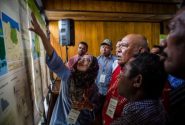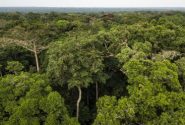
Peter Holmgren, CIFOR’s Director General, addresses Forest Day participants in Doha, Qatar. Neil Palmer (CIAT).
DOHA, Qatar (6 December, 2012)_An integrated landscape approach for resource management has the potential to assist with global challenges such as food security and climate change, however cross-sector cooperation will be a requirement for its success, according to a newly released CIFOR report summarising the outcomes of Forest Day 6.
Speakers at the event also discussed the need for strong social and biodiversity safeguards and private sector engagement in the UN-backed REDD+ scheme for sustainable development.
Read the summary report below.
*************
The sixth and final Forest Day took place in Qatar, Doha, on December 2, in parallel with the eighteenth UN Climate Change Conference of the Parties (UNFCCC COP18) convened from 26 November – 7 December 2011. There were more than 800 participants from 87 countries at Forest Day, including some 220 negotiators and members of UNFCCC country delegations. Scientists, researchers, activists, representatives from non-governmental and indigenous people’s organisations and the private sector were also in attendance. Co-hosted by the Centre for International Forestry Research (CIFOR) and the Collaborative Partnership on Forests (CPF), Forest Day 6 was convened under the theme “Living Landscapes,” with a special focus on the interconnections between forests and agriculture and their impacts on people and society.
For a brief history of forests and climate change, read last year’s report on Forest Day 5 by the International Institute for Sustainable Development (IISD).
OPENING PLENARY
Peter Holmgren, CIFOR’s new Director General, welcomed participants to Forest Day 6 and framed the day by declaring that the time has come to look at new ways of solving old problems. Climate change needs to be dealt with across sector boundaries, he said, and forestry must be looked at through the lenses of agriculture, food security and broader sustainable development.
Eduardo Rojas-Briales, Chair of the Collaborative Partnership on Forests (CPF) echoed this thought, adding that Forest Day needs to evolve in accordance with cross-cutting themes to support a growing awareness of the need to cope with 9 million global inhabitants by 2050.
Will Steffen, Executive Director of the Climate Change Institute at the Australian National University, delivered the keynote speech. He discussed the nine planetary boundaries and how they have the potential to change approaches to growth and sustainable development. He placed special emphasis on the boundaries of climate and biodiversity, and highlighted a need to move towards environmental stewardship rather than thinking only about usage.
Wu Hongbo, United Nations Under-Secretary-General for Economic and Social Affairs, highlighted the invisible income that forests contribute to rural livelihoods, with the formal cash contributions of forests to developing economies totaling US$326 billion — more than twice the size of total official development assistance (ODA) flows.
Ephraim Kamuntu, Minister for Water and the Environment in Uganda, also pointed out the need to ensure that rural livelihoods are tackled as part of the climate change agenda. Overcoming climate change challenges is tied intrinsically to the eradication of poverty in developing countries, he said.
DISCUSSION FORUMS
Watch individual discussion forums on our YouTube page here.
Forests on a cultivated planet
In this session, there was wide consensus that REDD was simply not achievable without enhanced agricultural production and improved social equity. The challenge of food security must be addressed, and REDD is now being viewed as a way to build national land use planning capacity, which could have flow on effects to agriculture. It was also clear from this session that forest conservation can contribute to innovations in climate smart agriculture, further validating the potential of a landscape approach to land management.
Read a Q&A on these issues with Deborah Bossio, the keynote speaker from this session.
Governance frameworks for REDD+
In the context of ensuring effective REDD+ implementation, the session focused on achieving equitable outcomes for local stakeholders. The experiences of the Democratic Republic of the Congo, Brazil, Mexico and Indonesia all pointed to the need for legal reforms to clarify and enforce customary and tenure rights so that REDD+ benefits could trickle down to individuals. Governments must consult and engage with these communities as well as civil society and research organisations, who will respectively hold governments to account and guide relevant policies. Additionally, governments must further address legal inconsistencies relating to land use and planning and endeavor to enhance coordination among agencies to improve the enforcement of REDD+.
Read a Q&A on these issues with British MP Barry Gardiner, the keynote speaker from this session.
National forest monitoring systems for REDD+
This session proposed that the functions of REDD+ National Forest Monitoring Systems (NFMS) should go beyond estimating GHG emissions and removal from forests; they should be set up to include multiple sectors and local stakeholders who want to engage in REDD+. NFMS should be relevant for national policy implementation — if systems can include socioeconomic issues, it is likely that countries can gain a deeper understanding of drivers of deforestation and how to tackle them. National capacities to monitor forests are variable and where there are capacity gaps, they should be built via a stepwise approach. Good institutional operation at the national level is one of the key challenges in developing NFMS.
Drivers of deforestation: Exploring regional differences and new patterns
Speakers in this session discussed both present and future drivers of deforestation. Doug Boucher stressed that need to be alert to emerging drivers, as they are dynamic and fast changing. Meine Van Noordvijk from the World Agroforestry Centre said drivers are more important than deforestation rates – because we “need to know the direction of the bus, not just the speed” – and also discussed conflicting definitions of what counts as a forest. Members of the audience discussed among themselves important questions about drivers. Some concerns raised were the demand side of drivers and sustainable consumption; using participatory processes for identifying drivers; and that “not all deforestation is bad.”
Forest landscape restoration: Enhancing more than carbon stocks
Speakers in this session noted that more than 2 billion hectares of land had the potential to undergo forest landscape restoration (FLR). Two key myths need to be overcome, they said: that FLR costs too much and takes too long. The Bonn Challenge calls for 150 million hectares of degraded forest to be restored by 2020 and it is estimated that achieving this goal will generate nearly $80 billion per year in additional income for communities living in and around forests. IUCN’s Plant a Pledge campaign to restore 150 million hectares commenced earlier this year and is aimed at supporting the Bonn Challenge. The human rights aspect of FLR was also stressed, given that so many people depend on forests for food, livelihoods and shelter. During the ensuing dialogue, the speakers and panelists discussed how to scale up FLR efforts. It was noted that there is a lot of data available at the macro level but there is a need for more national level information, hence REDD+ projects can and should seek to generate national information on FLR opportunities.
Watch an interview with Bianca Jagger, Plant a Pledge’s campaign ambassador.
Mangroves under pressure: Forgotten wetlands in the changing climate
This section will be updated with key findings from Discussion Forum’s rapporteur.
There is a lack of awareness of the importance of mangroves and their protection as a crucial part of climate change mitigation and adaptation efforts. New research shows that mangroves store exceptionally more carbon than tropical forests. However, a 30%-50% decline in mangroves over the past half-century has raised fears that they may disappear in 100 years. This session explored the role that mangroves play in combating climate change, their current status and successful restoration programmes.
Financing REDD+: Closing the gap
Despite considerable political and regulatory uncertainties, including the architecture of a long-term climate agreement and the role of REDD+ within that, there is a lot that can and should be done now to protect forests and further the objectives of REDD+. What happens between now and 2020 will be formative for the forest protection agenda. Meaningful progress from where we are today will require much more than fast-start pledges: REDD+ finance must be adequate and predictable and while conceptual progress has been made, political will and flexibility is needed in the application of available financing. Strong, credible environmental and social safeguards are key in encouraging risk-averse investors who may have been hanging back until now. Finance sustainable forestry and forest management needs to be seen as a whole, and REDD+ needs to be seen in that broader context and long-term timeframe.
Towards a consensus on carbon emissions from tropical deforestation
Panelists in this Discussion Forum discussed methodologies, data and technologies necessary to help other researchers and governments better understand emissions from deforestation, degradation and other land-use issues. The discussions included policy context and REDD+ implications, rationale for and approach to collaboration, research findings, and the need for future research advancements in the field.
REDD+, biodiversity and people: Opportunities and risks
Members of the Global Forest Expert Panel on biodiversity, forest management and REDD+ presented seven key findings of new report showing a strong link between biodiversity and carbon. The report also covers a wide array of issues that need to be addressed in REDD+ (such as the need to include socio-economic objectives early on in REDD+ planning and implementation and the importance of an integrated landscape management approach to reconcile environmental, social and economic considerations relevant to REDD+).
Speakers highlighted that the study calls for consistent policies at the international, national and subnational levels that take into account existing local governance structures. The speakers also stressed the importance of immediately progressing with REDD+ implementation and learning by doing rather than holding off on action while trying to find the perfect blue print.
Read a Q&A with the authors of the report here.
HIGH LEVEL SESSION
Speakers in the High Level Session, who were members of international institutions or government agencies, discussed how they had begun to integrate many of their departments to tackle the challenges of sustainable development and landscapes as a whole. All participants stressed the need for cross-sector cooperation to end the silos that have prevented effective policy in the past and to better integrate sectors (not just agriculture and forestry, but also finance and planning) to take a multi-landscape approach to development. REDD+ was seen as a new opportunity to discuss a cross-sector approach to aligning development and poverty reduction imperatives while sustaining landscapes and reducing emissions. Finance, improvements in education and information sharing at the national and local level, as well as the development of new technologies/techniques to increase productivity, were cited as potential solutions to the new challenges of operating across landscapes.
CLOSING PLENARY
Peter Holmgren gave a roundup of the discussions that had taken place throughout the day. A commemorative video was shown, charting the history of Forest Day from its beginnings in Bali to present day. Tony La Viña gave participants an update of the current state of REDD+ negotiations and his projections for the second half of the week. Jane McAlpine spoke about the impact of the International Year of Forests in raising the profile of forests in a positive way, and highlighted some of the entrepreneurial ideas and creative solutions to many of the challenges facing forests by local people on the ground. Tony Simons reflected on the history of Forest Day with a look towards how a ‘climate-smart landscape approach’ would be needed to tackle the future challenges related to agriculture, forests and climate change. Peter Holmgren concluded the last Forest Day at the UNFCCC COP by expressing his thanks to all the stakeholders, partners and participants who had made Forest Day a huge success over the past six years.
For videos from Forest Day, including interviews with speakers on the sidelines of the event, visit our YouTube channel.
For more CIFOR coverage of COP18 and Forest Day 6, click here.
We want you to share Forests News content, which is licensed under Creative Commons Attribution-NonCommercial-ShareAlike 4.0 International (CC BY-NC-SA 4.0). This means you are free to redistribute our material for non-commercial purposes. All we ask is that you give Forests News appropriate credit and link to the original Forests News content, indicate if changes were made, and distribute your contributions under the same Creative Commons license. You must notify Forests News if you repost, reprint or reuse our materials by contacting forestsnews@cifor-icraf.org.












